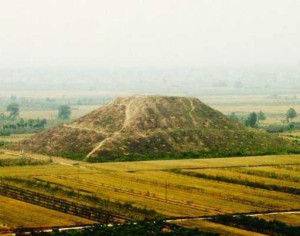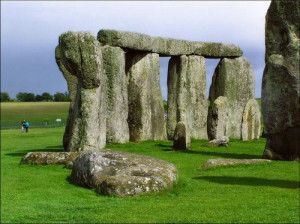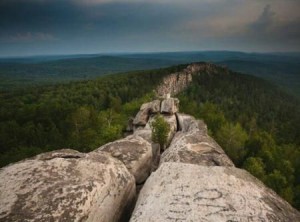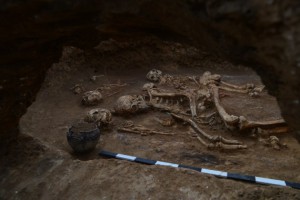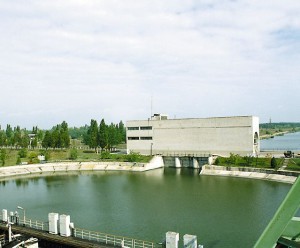Early megalithic structures of Asia Minor
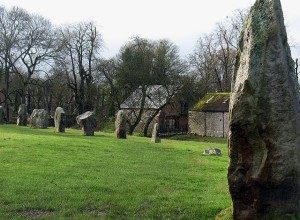 Large ceremonial structures IX Millennium BC have been discovered in Asia Minor. They belong to the era of the emergence of agriculture and animal husbandry in the society, under the influence of or directly from it happened later middle Eastern and European Neolithic. Structures are a large circle patterns, based on megalithic columns (3 m or more) of solid hewn stone. The most ancient of nowadays known are the temples of Göbekli Tepe and Nevali-Chori. In the Göbekli Tepe thus far excavated only four churches out of about two dozen. The diameter reaches some 30 m. On the columns there are bas-relief images of animals (foxes, boars, lions, birds, snakes and Scorpions) [6]. Although these temples are the oldest megalithic structures on Earth, it is unknown how they are related to European megaliths [7] .
Large ceremonial structures IX Millennium BC have been discovered in Asia Minor. They belong to the era of the emergence of agriculture and animal husbandry in the society, under the influence of or directly from it happened later middle Eastern and European Neolithic. Structures are a large circle patterns, based on megalithic columns (3 m or more) of solid hewn stone. The most ancient of nowadays known are the temples of Göbekli Tepe and Nevali-Chori. In the Göbekli Tepe thus far excavated only four churches out of about two dozen. The diameter reaches some 30 m. On the columns there are bas-relief images of animals (foxes, boars, lions, birds, snakes and Scorpions) [6]. Although these temples are the oldest megalithic structures on Earth, it is unknown how they are related to European megaliths [7] .
European megaliths
Megaliths are prevalent worldwide mainly in coastal areas. In Europe they mostly date back to the Eneolithic and bronze age (3rd — 2nd mill B. C.), with the exception of the British Isles. Portugal and France. where megaliths belong to the Neolithic period (for example, Carrowmore in Ireland. Almendres in Portugal,Barnen in Brittany and Buganski necropolis in the Department of Poitou — Charentes. France). Megalithic monuments are especially numerous and diverse in Brittany. Also a large number of megaliths found on the Mediterranean coast of Spain. in Portugal. part of France. on the West coast of England, in Ireland. Denmark. on the southern coast of Sweden and in Israel. In the early twentieth century it was widely believed that all megaliths belonged to one global megalithic culture. but modern research and Dating methods disprove this assumption.
The most common megalithic structure in Europe — the dolmen is a chamber or vault standing upright hewn monoliths, on which rests one or more large flat stones that make up the “roof”. Many of them, though not all, contain the remains of people buried inside. If the main purpose of burial buildings, or humans were sacrificed, was buried within in connection with the performance of their any rituals for life or stayed in the dolmen for any other reason, is unknown. The dolmen — the General name for such buildings, in different languages and dialects of Europe it can also have other names, such as cromlech (Welsh ), Anta (Portuguese ) or stazzone (in Sardinia ).
The second most common type of megalithic burials — the tomb of the corridor. Usually it consists of a rectangular, circular or cruciform chamber with a flat or protruding on the edges of the roof, which leads to a long straight passage. The entire structure from above covers the land, form a sort of mound, into which opens the entrance of boulders. Sometimes on the edge of the mound bordered by a stone kerb. The most remarkable examples — brú na bóinne in Ireland. Brin-Kelly Dee in Wales. Mashau in Orkney and Gabrini in Brittany .
The third type is a variety of tombs in the form of galleries, for example, Severn-Cotswold. In the plan they have axial symmetry and are composed of rows of chambers covered with mounds elongated shape. Distributed as free-standing or grouped menhirs and stone circles, which in Russian literature also known as cromlechs. like the dolmens of Wales. The latter type include the Stonehenge. Avebury. Circle Brodgar and hundreds of other similar monuments. As menhirs, they had the astronomical value of the devices for observing the sun and moon and are generally not as ancient as the megalithic burial.
